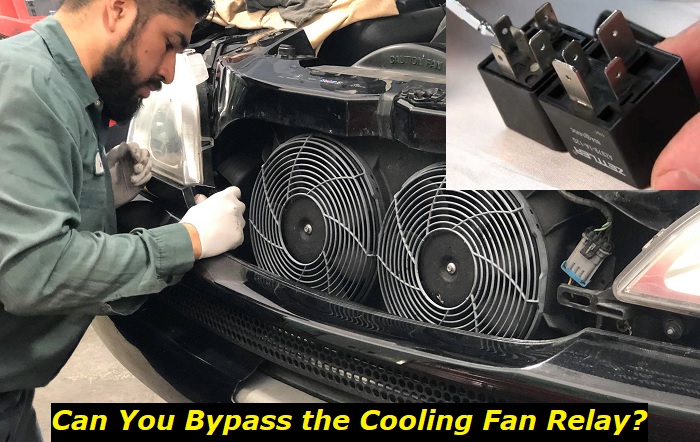You may have heard a lot about bypassing the cooling fan relay at some point or you may have read about its supposed benefits in various discussions online. Some may also have you tricked into believing that bypassing the cooling fan relay will increase its effectiveness. So now, you may be thinking of doing this.
Relay problems highlights
- Level of urgency:medium
- DIY inspection:possible but complicated
- DIY repairs:possible
- Can you drive?depending on the relay in question
- Price of repairs:$30 - $250
- Ifignored:certain functionswon'twork
- Ways to fix:checking the relay is difficult,professional help may be needed

How the Cooling Fan and the Cooling Fan Relay Work
Before diving into this hot topic, let's take a quick recap of how the cooling fan as well as its relay works for a moment. A cooling fan is a vital component in any vehicle. It helps circulate air and coolant within the radiator to keep the engine cool. Meanwhile, the cooling fan relay is an important part of the cooling system as it controls the power flowing to the fan.
Without a properly functioning cooling fan relay, the cooling fan would seize its functions causing the engine to overheat, which would lead to serious damage.
Bypassing the Cooling Fan Relay
There are many who resort to bypassing the cooling fan relay if their cooling fan suddenly stops functioning or if they want to keep their cooling fan running all the time. This is usually accomplished by connecting the battery directly to the cooling fan. The resulting setup will allow the fan to ensure airflow and to continue aiding the radiator in circulating coolant, which would help keep the engine from overheating.
If your cooling fan relay has failed, there are a few ways you can bypass it. This will allow your cooling fan to continue running even if the relay is not functioning properly. One common way of doing this is by directly bridging the cooling fan directly to the battery.
First, disconnect the negative terminal of the battery. Then, remove the cooling fan relay from its location. Next, connect one end of a jumper wire to the positive terminal of the battery and the other end to the connector on the cooling fan. Finally, reconnect the negative terminal of the battery.
Why This is a Bad Idea
Even as a last resort, we don't really recommend this method of reviving or supposedly enhancing the operation of your cooling fan. As you will learn here, it will certainly be more trouble than its worth.
Here are the things that you will most likely run into if you choose to go through this:
1. Quick Battery Drain
This bypass will allow the cooling fan to operate continuously, which may drain your battery quickly. It is therefore important to monitor your battery level and disconnect the jumper wire when there's no need to keep the fan running.
Note that this setup can also make the fan constantly operate even if the engine is off. So, if you ever forget to manually remove the bypass or turn off the fan while you are parked for a few hours or overnight, then prepare to be greeted by a drained battery later on.
2. Alternator Quick Wear
If you bypass the cooling fan relay to get the cooling fan running all the time, you are potentially putting a lot of strain on the alternator. The alternator is responsible for charging the battery powering the cooling fan, and if it has to run constantly, it can wear out quickly.
3. Fan Motor Damage
When a car's cooling fan is running continuously, it can put unnecessary wear on the fan motor. The nonstop operation can cause the motor to overheat and potentially fail prematurely.
Of course, when your fan fails, you get your engine closer to overheating, which would defeat your purpose of bypassing the cooling fan relay in the first place.
4. Damage to the Vehicle's Electrical System
Additionally, bypassing the cooling fan relay can also put stress on the car's electrical system, which could lead to other problems down the road. The improper installation of the bypass will likewise increase the risk of tackling more electrical issues later on.
5. Warranty Loss
When the cooling fan relay is bypassed, the vehicle's cooling system will no longer be able to regulate the temperature of the engine based on its original design. This can expose the engine to overheating, which can lead to serious damage.
The worse is that you may not be able to use your warranty in the ensuing repairs because any damage resulting from modifications is normally out of the coverage offered by the agreement. Therefore, prepare to fork out a hefty sum for repairs or parts replacements plus labor should your project result in such a scenario.
Fixing a Faulty Cooling Fan
Instead of bypassing its relay, the best way around a cooling fan problem is by fixing the part that is really causing it in the first place. If your vehicle's cooling fan is not working properly, there are several potential causes that you have to check out. This section will help you diagnose the problem and find a long-term solution.
As mentioned above, cooling fans are an essential part of a vehicle's cooling system. When the engine is running, the fans help to circulate air and keep the engine cool. If the fans are not working properly, the engine can overheat, which can lead to serious damage.
There are two types of cooling fans: electric and mechanical. Electric fans are more common in newer vehicles, while mechanical fans are more common in older vehicles. No matter which kind of fan you are equipped with, these solutions will still come in handy.
1. Faulty Thermostat
Most cooling fans are controlled by a thermostat. When the engine temperature gets too high, the thermostat turns on the fan. With that, one of the most common culprits to this issue is a faulty thermostat. If the thermostat is not working properly, it will not turn on the fan when the engine gets too hot.
So, if you suspect that your cooling fan is not working properly, the first thing you should do is check the thermostat. If the thermostat is not working, it will need to be replaced.
Typically, this kind of work will only cost you $200 to $300. This already includes the part replacement and labor but it does not take into account other parts that may have been affected by the issue.
2. Bent Fan Blades
A second possible cause is a problem with the fan itself. If the blades are damaged or bent, the fan will not be able to rotate as intended. If the blades are damaged or bent, the cooling fan will need to be replaced.
Depending on the product and prevailing labor costs in your area, a cooling fan assembly replacement would drive you north of $600.
3. Electrical Issues
Another possible cause is a problem with the electrical system that controls the fan. This could be a blown fuse or a problem with the wiring. If you spot a blown fuse, it will need to be changed with a new one that has the same amperage. If there is a problem with the wiring, it will need to be repaired or replaced, too.
A new fuse will only cost you $10 to $20 plus labor of around $65 to $100 if you want a professional to do it for you. Meanwhile, a cooling fan relay replacement is dirt cheap at $120 to $160, including the fee for the labor.
4. Coolant Leak
Finally, one more possible cause of a seizing cooling fan is an engine coolant leak. If there is a leak in the cooling system, the engine can overheat and damage the fans. If all of the other potential causes have been ruled out, it is likely that the problem is an engine coolant leak. If there is a leak in the cooling system, it will need to be repaired by replacing the seals, gasket, O-ring, radiator cap, or any other parts causing it.
This kind of repair usually starts at $100. The amount could easily blow up depending on the gravity of the damage.
If you are having trouble diagnosing the problem, or if you need help finding the parts you need to fix it, feel free to contact a professional mechanic. They will be able to help you get your vehicle's cooling system back up and running properly.
Conclusion
Due to the numerous risks involved, bypassing the cooling fan relay should be avoided at all costs. The best way around this problem is to have the fan or the relay repaired or replaced by a mechanic if any of them is already malfunctioning or has seized its functions. This also includes the other parts that may be affecting the proper operation of the fan.
At the end of the day, the amount that you will be spending for repairs or replacement will prove to be a better investment than taking your chances on this kind of mod that could potentially damage your engine and other parts of your vehicle.
About the authors
The CarAraC research team is composed of seasoned auto mechanics and automotive industry professionals, including individuals with advanced degrees and certifications in their field. Our team members boast prestigious credentials, reflecting their extensive knowledge and skills. These qualifications include: IMI: Institute of the Motor Industry, ASE-Certified Master Automobile Technicians; Coventry University, Graduate of MA in Automotive Journalism; Politecnico di Torino, Italy, MS Automotive Engineering; Ss. Cyril and Methodius University in Skopje, Mechanical University in Skopje; TOC Automotive College; DHA Suffa University, Department of Mechanical Engineering






Add comment